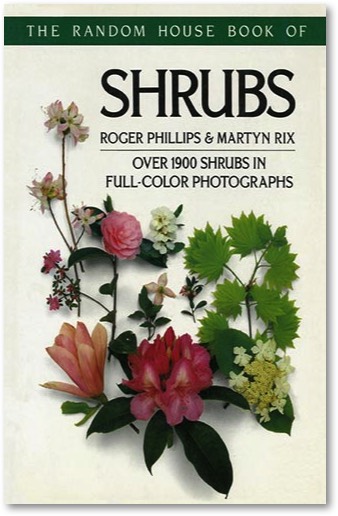
Musings » The Random House Book of Shrubs


New York
Random House 1989
Rogers and Rix are a wonderful pair. Each brings special strengths to the partnership. Roger Philips is an inspired photographer with a strong interest in plants and Martyn Rix is a distinguished taxonomist at the Royal Horticultural Society’s Wisley garden. I first came across them in their delightful book about roses, reviewed a few years ago in our Garden Gazette. Together they have received many honors such as being named some of the Great Rosarians of the World at the Huntington.
Roger Phillips developed a technique for photographing flowers against the background of a light box. Flowers look so much more beautiful with all the detail revealed. The book about roses contained an almost stupefying amount of information about the history and current status of the rose in a fairly compact space. The project rose (pardon the pun!) out of a special TV show in England.
Since they started to work together they have issued numerous books on many aspects of gardening and plants: herbs, bulbs, trees, early perennials, late perennials and even vegetables.. The one being discussed here is part of a long series. Philips has applied his light box technique to single branches and twigs thus highlighting the shrubs’ individual characteristics. There is such vast number of ornamental shrubs in commerce, it is very hard to keep them all straight without a score card. Phillips and Rix give us that card.
They very sensibly organize the book around the seasons, starting with plants which flower in winter. The initial pages are devoted to the background and origin of many commonly grown and much loved Asian plants here in the west. Both Phillips and Rix have been on useful plant hunting and collecting trips in China and speak with first hand knowledge.
Winter is not an issue for us here in the Bay area. Almost all the shrubs we commonly grow remain active in the winter but in the colder zones finding a shrub which has colorful berries, bark or even blossom is a real achievement. The value of a book like this is the huge number of options it offers when one’s own knowledge is modest and even the local nurseryman cannot make too many suggestions. The end of the book is very helpful with a list of sources and gardens to visit.
One tends to forget the great beauty of the witch hazels, Hamamelis, in the fall and winter. Mahonia has yellow leaves with purple berries in late fall. You can see handsome specimens outside the County Fair building. Arbutus, Jasmine nudiflorum and Viburnum are other winter stalwarts.
A genus we probably never think about, Correa, is much more tender but its pendant flowers, usually red, resemble fuchsia a bit. The SF Botanical Garden has many exquisite Correas. Clianthus and Pittosporum are featured but I can only mention a fraction of the plants carefully described. The authors include both showy and less obviously exciting plants such as some of the Leptospermums and Ericas.
Even though this book seems to be inexhaustible it has to represent somewhat arbitrary choices in order to get produced. The authors had to decide what they wanted to include and what had to be left out. One major category of shrub is the rose. It is hardly surprising that there are no roses in this book because that genus has taken on a life of its own, almost becoming an industry.
The camellia section is abbreviated. There are thousands of gorgeous camellias available but the format of each page with a picture of the plant and a brief description limits what can be included.
Maples are included. We are accustomed to thinking of maples as trees but when they are very small without a central trunk then they have shrub like qualities. The authors address this matter in their introduction. They take the sensible view that the distinction between a tree and a shrub can be arbitrary at times. It really boils down to “I know it when I see it”.
We often plant shrubs to be a basis for other plants and so need to see them in the whole. Their habit is very important. Some are neatly mounded and very well behaved. Others are floppy or uninhibited but endear themselves to us because of their blossom or fragrance. Thus we see them in two planes. One is at a distance and the other is close up. Consider the virtues of a plant which performs well on both scores. Azaleas and rhododendrons are good examples. Quite a few pages are devoted to both species and hybrid rhododendrons.
Even though this book was written more than 20 years ago I recommend taking a look at it. I shall put my copy in the library for anyone to peruse whenever they are in the office.
Copyright © Judith M. Taylor August 2011

